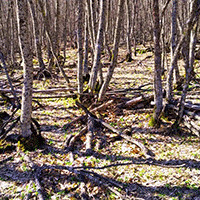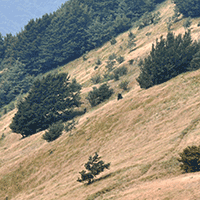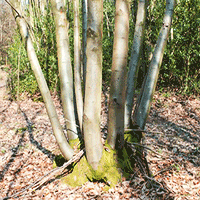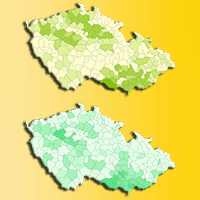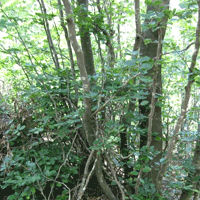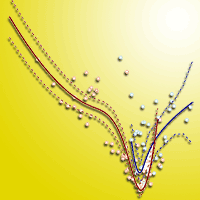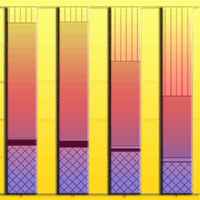Forest stand structure is influenced by artificial factors such as silvicultural activities, and by natural factors such as wildfires, floods, windstorms, diseases, and insect infestations. The silvicultural treatments used during the transformation of coppice to the coppice-with-standard system are a main source of coarse woody debris (CWD). Even small changes in the amounts and/or types of CWD can threaten forest biodiversity, including plant and bird diversity. In this study, we compared managed and unmanaged forest stands in Northwest Iran to better understand changes in species composition and stand characteristics (with particular reference to CWD) in relation to silvicultural practices. In total, thirty-six 0.5-hectare sampling plots were surveyed (total area: 18 ha). We found significant differences between the cut (active management) and uncut areas (proforestation) in indices of height, number of tree species, canopy cover of live and fallen trees, dead tree density, and relative frequency of dead trees. The sample plots included 22 species of live trees, and the CWD was generated by 16 of these species. The number of stems of live trees in the sample plots was 2.653 (SE = 181), with Carpinus orientalis accounting for the highest mean density of live trees. C. orientalis also provided the highest total frequency of downed logs (70%) in the stands, followed by Quercus macranthera (20%). Q. macranthera accounted for the highest relative frequency of dead trees in the stands. In total, around 42% of the CWD consisted of logs lying on the forest floor, followed by dead trees (39%) and stumps (19%). Most of the CWD was included in decay class (DC) 2 (71.6%), followed by DC1 (16.7%) and DC3 (11.3%). Forest managers must balance the amount of CWD, especially from dead trees, in these stands to conserve the diversity of the material in terms of both decay class and tree species.
Keywords
, , , ,
Citation
Ghanbari S, Sefidi K, Álvarez-Álvarez P, Fathizadeh O, Abbasnezhad Alchin A (2023). Effects of silvicultural thinning on stand structure and coarse woody debris in the deciduous Arasbaran forest, Iran. iForest 16: 377-384. - doi: 10.3832/ifor4312-016
Academic Editor
Giorgio Alberti
Paper history
Received: Jan 19, 2023
Accepted: Oct 15, 2023
First online: Dec 19, 2023
Publication Date: Dec 31, 2023
Publication Time: 2.17 months
© SISEF - The Italian Society of Silviculture and Forest Ecology 2023
Open Access
This article is distributed under the terms of the Creative Commons Attribution-Non Commercial 4.0 International (https://creativecommons.org/licenses/by-nc/4.0/), which permits unrestricted use, distribution, and reproduction in any medium, provided you give appropriate credit to the original author(s) and the source, provide a link to the Creative Commons license, and indicate if changes were made.

Breakdown by View Type
(Waiting for server response...)
Article Usage
Total Article Views: 15084
(from publication date up to now)
Breakdown by View Type
HTML Page Views: 11797
Abstract Page Views: 1892
PDF Downloads: 1048
Citation/Reference Downloads: 0
XML Downloads: 347
Web Metrics
Days since publication: 727
Overall contacts: 15084
Avg. contacts per week: 145.24
Article Citations
Article citations are based on data periodically collected from the Clarivate Web of Science web site
(last update: Mar 2025)
(No citations were found up to date. Please come back later)
Publication Metrics
by Dimensions ©
Articles citing this article
List of the papers citing this article based on CrossRef Cited-by.
(1)
Baran J, Pielech R, Kauzal P, Kukla W, Bodziarczyk J (2020)Influence of forest management on stand structure in ravine forests. Forest Ecology and Management 463: 1-9.
CrossRef |
Gscholar
(2)
Behjou FK, Lo Monaco A, Tavankar F, Venanzi R, Nikooy M, Mederski PS, Picchio R (2018)Coarse woody debris variability due to human accessibility to forest. Forests 9: 509.
CrossRef |
Gscholar
(3)
Brzeziecki B, Bielak K, Bolibok L, Drozdowski S, Zajaczkowski J, Zybura H (2018)Structural and compositional dynamics of strictly protected woodland communities with silvicultural implications, using Bialowieza Forest as an example. Annals of Forest Science 75 (3): 18.
CrossRef |
Gscholar
(4)
Gayo L (2022)Influence of afforestation on coleopterans abundance and diversity at the University of Dodoma, Tanzania. Environmental and Sustainability Indicators 16 (4): 100208.
CrossRef |
Gscholar
(5)
Ghanbari S, Heshmatol Vaezin SM, Shamekhi T, Eastin IL (2014)Market expansion’s influence on the harvesting of non-wood forest products in the Arasbaran forests of Iran. The Forestry Chronicle 90: 599-604.
CrossRef |
Gscholar
(6)
Ghanbari S, Jafari M, Nasiri V (2015)Effects of conservation programs in changing the pattern of fuel consumption of villagers in the Arasbaran forests. Journal of Forest Research and Development 1: 67-83.
Online |
Gscholar
(7)
Ghanbari S, Heshmatol Vaezin SM, Shamekhi T, Eastin IL, Lovrić N, Aghai MM (2020)The economic and biological benefits of non-wood forest products to local communities in Iran. Economic Botany 74: 59-73.
CrossRef |
Gscholar
(8)
Gibb H, Ball JP, Johansson T, Atlegrim O, Hjältén J, Danell K (2005)Effects of management on coarse woody debris volume and composition in boreal forests in northern Sweden. Scandinavian Journal of Forest Research 20: 213-222.
CrossRef |
Gscholar
(9)
Guillemot J, Klein EK, Davi H, Courbet F (2015)The effects of thinning intensity and tree size on the growth response to annual climate in
Cedrus atlantica: a linear mixed modeling approach. Annals of Forest Science 72: 651-663.
CrossRef |
Gscholar
(10)
Haeussler S, Bedford L, Leduc A, Bergeron Y, Kranabetter J (2002)Silvicultural disturbance severity and plant communities of the southern Canadian boreal forest. Silva Fennica 36: 307-327.
CrossRef |
Gscholar
(11)
Herrero C, Krankina O, Monleon VJ, Bravo F (2013)Amount and distribution of coarse woody debris in pine ecosystems of north-western Spain, Russia and the United States. iForest 7: 53-60.
CrossRef |
Gscholar
(12)
Jakoby O, Rademacher C, Grimm V (2010)Modelling dead wood islands in European beech forests: how much and how reliably would they provide dead wood? European Journal of Forest Research 129: 659-668.
CrossRef |
Gscholar
(13)
Kapusta P, Kurek P, Piechnik L, Szarek-Lukaszewska G, Zielonka T, Zywiec M, Holeksa J (2020)Natural and human-related determinants of dead wood quantity and quality in a managed European lowland temperate forest. Forest Ecology and Management 459: 117845.
CrossRef |
Gscholar
(14)
Krankina ON, Harmon ME, Kukuev YA, Treyfeld RF, Kashpor NN, Kresnov VG, Skudin VM, Protasov NA, Yatskov M, Spycher G (2002)Coarse woody debris in forest regions of Russia. Canadian Journal of Forest Research 32: 768-778.
CrossRef |
Gscholar
(15)
Kumar P, Chen HY, Thomas SC, Shahi C (2017)Effects of coarse woody debris on plant and lichen species composition in boreal forests. Journal of Vegetation Science 28: 389-400.
CrossRef |
Gscholar
(16)
Lewis SL, Wheeler CE, Mitchard ET, Koch A (2019)Restoring natural forests is the best way to remove atmospheric carbon. Nature 568: 25-28.
CrossRef |
Gscholar
(17)
Liu X, Trogisch S, He J-S, Niklaus PA, Bruelheide H, Tang Z, Erfmeier A, Scherer-Lorenzen M, Pietsch KA, Yang B (2018)Tree species richness increases ecosystem carbon storage in subtropical forests. Proceedings of the Royal Society B 285: 20181240.
CrossRef |
Gscholar
(18)
Moomaw WR, Masino SA, Faison EK (2019)Intact forests in the United States: proforestation mitigates climate change and serves the greatest good. Frontiers in Forests and Global Change 2: 182.
CrossRef |
Gscholar
(19)
Msanga H, Masunga E, Andrew S, Fandey F (2018)Challenges of producing quality tree seeds to support afforestation in Tanzania. In: Proceedings of the “1st TAFORI Scientific Conference on Forestry Research for Sustainable Industrial Economy in Tanzania” (Kessy JF, Balama CP, Kagosi PJ, Bakengesa S, Pima NE, Mndolwa MA, Nkya SE eds). Morogoro (Tanzania) 24-2 Apr 2018, pp. 63-72.
Online |
Gscholar
(20)
Mutlu B (2019)The effect of afforestation on biodiversity in Malatya, Turkey. Applied Ecology and Environmental Research 17: 12787-12798.
CrossRef |
Gscholar
(21)
Negi VS, Maikhuri R (2017)Forest resources consumption pattern in Govind wildlife sanctuary, western Himalaya, India. Journal of Environmental Planning and Management 60: 1235-1252.
CrossRef |
Gscholar
(22)
Ongolo S, Giessen L, Karsenty A, Tchamba M, Krott M (2021)Forestland policies and politics in Africa: recent evidence and new challenges. Forest Policy and Economics 127 (1): 102438.
CrossRef |
Gscholar
(23)
Paletto A, De Meo I, Cantiani P, Ferretti F (2014)Effects of forest management on the amount of deadwood in Mediterranean oak ecosystems. Annals of Forest Science 71: 791-800.
CrossRef |
Gscholar
(24)
Parisi F, Frate L, Lombardi F, Tognetti R, Campanaro A, Biscaccianti AB, Marchetti M (2020)Diversity patterns of Coleoptera and saproxylic communities in unmanaged forests of Mediterranean mountains. Ecological Indicators 110 (5): 105873.
CrossRef |
Gscholar
(25)
R Core Team (2015)R: a language and environment for statistical computing. R Foundation for Statistical Computing, Vienna, Austria.
Online |
Gscholar
(26)
Rubino DL, McCarthy BC (2003)Evaluation of coarse woody debris and forest vegetation across topographic gradients in a southern Ohio forest. Forest Ecology and Management 183: 221-238.
CrossRef |
Gscholar
(27)
Rusaati BI, Joo S-H, Yun G-Y, Park J, Cephas MN, Kang J-W (2019)Assessment of coarse woody debris in gallery forest in the Bombo-Lumene Reserve (Democratic Republic of Congo). Journal of Forest and Environmental Science 35: 205-211.
Gscholar
(28)
Sagheb-Talebi K, Pourhashemi M, Sajedi T (2014)Forests of Iran: a treasure from the past, a hope for the future. Series “Plant and Vegetation”, vol. 10, Springer, Dordrecht, Netherlands, pp. 157.
CrossRef |
Gscholar
(29)
Saud P, Cram D, Smallidge S, Baker T (2018)Coarse woody debris following silviculture treatments in southwest mixed-conifer forest. Forests 9: 347.
CrossRef |
Gscholar
(30)
Sefidi K (2010)Characteristics of coarse woody debris in successional stages of natural beech (
Fagus orientalis) forests of Northern Iran. Journal of Forest Science 56: 7-17.
CrossRef |
Gscholar
(31)
Sefidi K, Mohadjer MRM, Mosandl R, Copenheaver CA (2013)Coarse and fine woody debris in mature Oriental beech (
Fagus orientalis Lipsky) forests of northern Iran. Natural Areas Journal 33: 248-255.
CrossRef |
Gscholar
(32)
Sefidi K, Etemad V (2014)The amount and quality of dead trees in a mixed beech forest with different management histories in northern Iran. Biodiversitas Journal of Biological Diversity 15: 162-168.
CrossRef |
Gscholar
(33)
Sefidi K, Esfandiary Darabad F, Azaryan M (2016)Effect of topography on tree species composition and volume of coarse woody debris in an Oriental beech (
Fagus orientalis Lipsky) old growth forests, northern Iran. iForest 9 (4): 658-665.
CrossRef |
Gscholar
(34)
Shorohova E, Kapitsa E (2015)Stand and landscape scale variability in the amount and diversity of coarse woody debris in primeval European boreal forests. Forest Ecology and Management 356: 273-284.
CrossRef |
Gscholar
(35)
Stephens SL, Moghaddas JJ (2005)Fuel treatment effects on snags and coarse woody debris in a Sierra Nevada mixed conifer forest. Forest Ecology and Management 214: 53-64.
CrossRef |
Gscholar
(36)
Tavankar F, Nikooy M, Picchio R, Venanzi R, Lo Monaco A (2017)Long-term effects of single-tree selection cutting management on coarse woody debris in natural mixed beech stands in the Caspian forest (Iran). iForest 10 (3): 652-658.
CrossRef |
Gscholar
(37)
Whitford K, McCaw W (2019)Coarse woody debris is affected by the frequency and intensity of historical harvesting and fire in an open eucalypt forest. Australian Forestry 82: 56-69.
CrossRef |
Gscholar
